The Lawyers Building: What Used to Remain of the State Theater
In a few days, Wake County will hold a ground breaking ceremony for the new Justice Center on Salisbury Street. One year ago, two buildings and a parking deck were demolished to make way for this new court house. While most (including myself) focused on the loss of the iconic Garland Jones Building, there were few voices lamenting the loss of the older Lawyers Building.
What made this building significant is that it was the last remaining part of the once grand State Theater, which opened in 1924 and closed around 1975. The Lawyers Building served as the entrance and lobby.
Roaring Into the Golden Age
The construction of the State Theater occured during the roaring 20s, a time in which Raleigh saw several large scale projects: The Sir Walter Hotel, The Odd Fellows Building, the Professional Building, and the Carolina Hotel, among others. It was built at a cost of $264,000 – putting the cost of a theater on par with many of the mid-rise projects around town.
It opened during “The Golden Age of Cinema”, which saw not only numerous building projects, but other theaters as well. The Almo and The Grand opened around the same time, a few years later saw the construction of the Capitol and Wake Theaters.
Showcasing Vaudeville and Silent Films
A typical Vaudeville performance (1929), location unknown
The mid 1920s were a transition period in America for entertainment. The predominant form of entertainment up until that point was Vaudeville, a which was essentially a series of live variety shows. Most theaters across the country at this time showed both Vaudeville as well as moving pictures.
A unique feature at the time was the use of an organ or cinematic orchestra to accompany the silent films. One such example was Charlie Chaplin’s Gold Rush, which screened while Raleigh residents provided the sound score.
As silent films became “talking pictures”, Vaudeville faded from existence as a form of public entertainment. The State Theater then began to show movies exclusively.
Decline and the Shift to the ‘Burbs
The State Theater continued to operate long after the “Golden Age”. In the early 1960s as urban populations shifted outward to the suburbs, it was one of only a couple of theaters downtown. By the mid 70s, Downtown Raleigh was similar to most other urban centers across the country: only a shadow of its former self. With most of the retail chains on Fayetteville Street making a dash for shopping centers such as Cameron Village and beyond, there was little drawing residents there.
As was the case with many urban theaters at the time, the movies shown shifted from family entertainment to those of an adult nature. It later closed in 1975.
From Place of Fun to Place of Incarceration

The Garland Jones Building in the middle foreground, behind it the Lawyers Building, and to the right the jail
An account on Cinema Treasures outlines when the theater came down:
I was present when the State Theatre was torn down for the Wake County Jail in the summer of 1987 on Salisbury St. The theatre was in ruins. The building in front of the State Theatre facing Salisbury St. is called the Lawyers Building and it is still there.
The theater itself came down to make way for the jail, but the Lawyers Building (above) continued to serve law firms for another 20 or so years.
Erasing the Remnants
At the end of April and beginning of May last year, the Lawyers Building and the Garland Jones Building were destroyed to make way for Wake County’s new Court House. The Lawyers Building was taken down floor by floor, until the last remnant (the foyer) of the State Theater were permanently removed.
Barnhill Contracting Company was kind enough to give me and a couple others a tour of this building and the Garland Jones Building shortly before it came down this time last year.
A Persistent Lack of Downtown Cinema
Although in past 6-7 years Raleigh has made significant shifts toward the city core, there is a lack of cinema options. There is the IMAX theater, but it is specialized for that format, and rarely shows the type of movie you can get lost in.
For that, the closest option is the historic Rialto Theater, located in the Five Points neighborhood. It’s a great theater and a favorite of mine. It isn’t far, but it’s not exactly a quick walk from downtown either.
It doesn’t seem likely that cinema will return to the city’s core, and it’s kind of sad. Theaters are a magnet for drawing visitors, and a missing key component (think dinner and a movie). The return on investment probably doesn’t add up for such a venture.
I hope I’m wrong on that one.
More Images of the State Theater and Lawyers Building
Further Reading:
- Movie Theaters of Downtown Raleigh (New Raleigh)
- State Theater (Cinema Treasures)

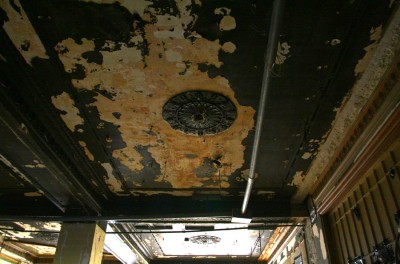
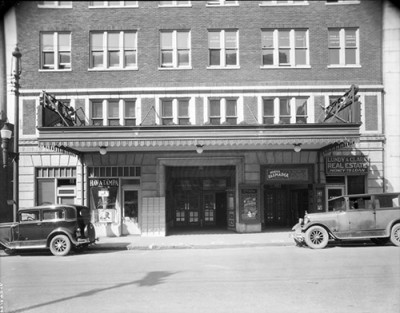
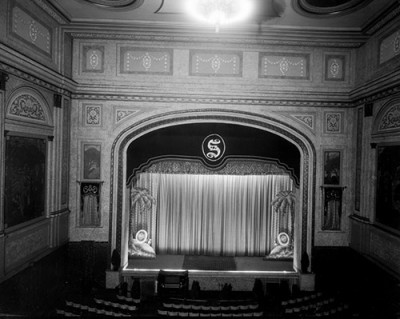
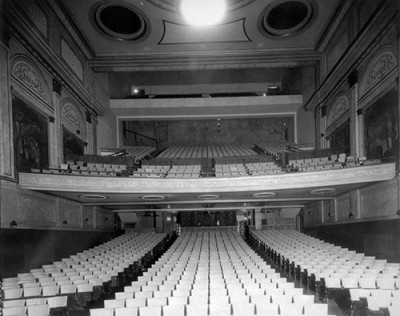
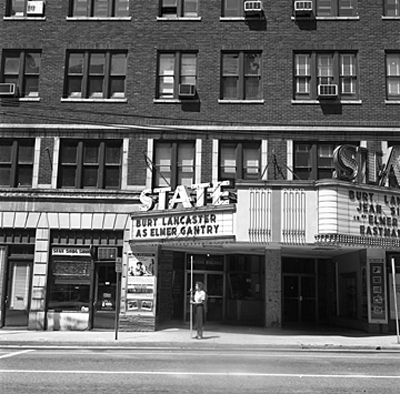


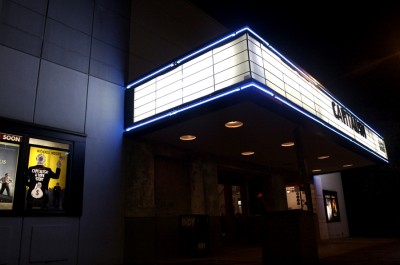
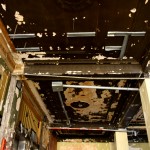

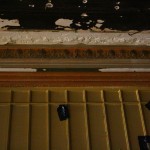
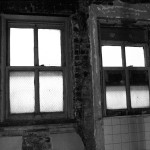
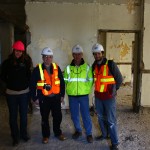
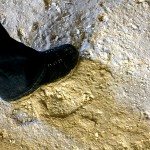
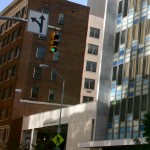
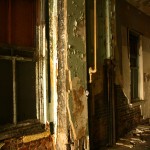

 Sign up for the Newsletter
Sign up for the Newsletter
05/09/2010
Great post. I hope you are wrong also.
05/09/2010
The first movie that I saw by myself, without parents or siblings, was Pollyanna, in 1960 at the State Theater. (Hayley Mills crush). Anyway my friends and I liked seeing movies there because is was adjacent to the Johnson-Lambe Sporting Goods where we could hang out before and after the movie. Raleigh lost a lot with the destruction of the State, Ambassador, and Wake theaters.
05/10/2010
Great post.
I remember going to several movies there, parking in the deck next door, and then walking over to the theater.
I mostly remember seeing “Earthquake” in 1974, in “Sensurround.” Seems like we also saw “Towering Inferno” there as well.
05/11/2010
A movie theater (and a grocery store) is needed if developers ever really want living in downtown Raleigh to make sense.
Issue with the IMAX, other than it being specialized, is that the management, as of a few years ago, will not show movies based on their rating. I found out about this when looking into seeing 300 in IMAX. Sigh.
A movie theater downtown would make for a great night out.
05/14/2010
The first movie I remember seeing was “The Sound of Music” at the Ambassador. I was 4 or 5. The lobby cards were advertising “What’s New Pussycat” and my parents had a difficult time answering my questions about the “coming attraction” — is it about animals, Mom?
05/14/2010
I’m not quite as old as Raleigh Native #421, but I can remember seeing many movies in the Old State Theater starting in the mid 1960’s and up to the mid 70’s. It was sad to see it became what it did, and then to close. Those were great memories, and history now long gone.
05/17/2010
I worked at the State (my first job ever) from the early 60’s til
1965. Sandy Jordan was my boss. Worked the box office, ticket
taking, consession stand, and on weekends popped popcorn. Used to
be a grand old place.
05/24/2010
I saw the Sound of Music there, when I was visiting Raleigh with my parents. I’m glad that I had the opportunity to see it.
06/09/2010
For a while in the late 70’s or early 1980’s the State Theater was a live music venue. Mike Silver, son of the Silver of McKinney, Silver and Rockett ran it. I believe that he also ran The Silver Bullet Saloon, which was in the space where Charlie Goodnight’s Comedy Club is now.
The Silver Bullet was either the first or the last (depending on your direction of travel) of the long string of bars and clubs on Hillsborough Street. Those are worth a major discussion in an of themselves.
Thanks to the drinking age being raised and a conscious attempt on the part of the city of Raleigh, Hillsborough Street was killed as a destination in the city, and now they are spending millions to revive it. Like people who move near the end of runways and complain about airplane noise, the residents near Hillsborough at the time complained about the bars and — GASP! — college students nearby.
08/29/2010
My brother Bobby (above) was the first, followed by another brother Tom, and lastly ME all worked at the State Theater! (at different times of course.) It was most definitely a grand place and I wish it was still there. I especially loved getting there early (before work time) and taking a “tour” back behind the screen. There were lots of old dressing rooms back there. The old stage was still back there too behind the screen. Being such a lover of anything old and vintage, I always zeroed in on anything I could find that might be still lingering around. Sure enough, I found names and dates of the actors who had worked there etched into one wall. The dates went back to the early twentieth century. Interesting!
Yes, in the late 70’s, they turned the theater into a nightspot and had lots of rock bands playing there. My brother’s band played there; it was pretty neat for the fact that they didn’t change anything inside. Everyone just sat in the audience seats as if they were there to see a movie.
The building you speak of that was called the Silver Bullet had previously been Charlie Goodnights nightclub and they had lots of good rock bands there; Jesse Bolt, Nantucket, Mother’s Finest, AND my brother’s band Topaz, to name a few. They changed it to the Silver Bullet in the late 70’s.
Sometime in the 80’s they changed it to a comedy club and it has stayed a comedy club ever since to this day.
It would be nice to be able to go back into time, just for a little while, and enjoy it all once again. I’ll always have memories of those good ol’ days.
09/29/2010
@Charles – You’re off a little bit. The State Nightclub was run by the son of Silver of MS&R…but that was me, Mark Silver (My dad was Mike).
It was in the 1977 time frame. My partner had been one of the original owners of Charlie Goodnights. I had been working at WQDR, and many of the other Q-crew pitched in, along with lots of other folks, and helped us to transform the place into the rock venue. (They all ‘earned’ free admission for as long as we were open!)
@Patti – you’re really close. We did do make some changes to the inside. We took out the first 10 or so rows for a dance floor/standing area and then removed every other row of seats and put in table tops on the armrests of the removed seats. We also constructed a bar in the downstairs snack bar area.
It was a really cool place. Some of the bands were: Mothers Finest, Nantucket, Razz, Sanford Townsend, Little River Band, and a slew of others. The stage was truly magnificant and rose up almost five stories.
We had a lot of ‘cool finds’ like old movie posters, cans and bottles from the 20’s, etc. The “colored balcony” had been boarded up for years, but would have made a great VIP lounge…had we remained open.
We originally opened on a bit of a ‘gamble’. “Liquour by the drink” looked like it had a good chance of passing at the time, but alas – the “dry vote” killed the law as well as out chance of making it. At the time – one could only purchase beer in a club or restaurant…not exactly a high-profit item!
04/08/2011
I remember seeing movies at the State Theatre as kid, and later going when it was rock n roll. That was such a cool place to hear bands. Too bad it’s gone–and for a jail. “If you build it they will come”? Thanks to all who shared some of the history in the comments and brought back great memories.
04/09/2011
While I don’t remember my first movie at the Ambassador, I do recall that the first movie I saw at The State was Walt Disney’s “Fantasia”. Although it was originally released in 1940 (before my time), I’m pretty sure I saw it before entering the first grade, which would have been the 1955-56 re-release of the film. I also remember seeing it in the evening….going downtown at night at that age = very big deal. And going to a grand movie palace like The State or Ambassador—what a treat!
09/22/2012
Great post.
An April 1954 issue of Boxoffice had a story on the State. You can see it here:
http://www.boxoffice.com/the_vault/page_thumbnails?issue_id=1954-4-3
07/05/2013
I’m one of the brothers Patti was speaking of above. The State truly was a grand old place. I quit my job at Hardee’s at sixteen years old to work there. As Patti mentioned my brother Bob had worked there in the earlier 60’s (think Bob’s above in comments also). I remember him getting Patti and I in to see The Beatles “Help”, & “Hard Day’s Night” when seeing a huge color movie screen was still relatively a ‘new’ thing.
While working there myself old Mr. Jordan (Sandy) might have been the typical “southern gentleman”, tough to work for at times, but always respected by most all he came in contact with, including myself for sure. I recall he had a glass eye, but he was a lot sharper with that one remaining eye than most I ever knew, he could literally “see around corners”, I can attest to that.
As Patti mentioned, the stage behind the screen was a super place to look through when we had time, the dressing rooms downstairs from there were cool to explore as well. Many a Saturday mornings I went down there to fetch popcorn that had been popped by old Bobby the projectionist.
The band I was with Patti mentioned was ‘Shotz’, our manager at the time was on great terms with Nantucket’s management and we ended up purchasing almost virtually all their lighting and sound system after they went on with Epic records around ’75 or 76′ I think. Wow, what memories. We were opening for Little River Band at The State on a night I had decided to get extremely drunk. Our opener was a Queen tune “Tie Your Mother Down”, when I tripped and fell off the drum riser just before the lights came up and the stage curtains were parting on the first power chord…talk about lucky, nobody but front row saw anything. Right after that set, our guitarist/singer Steve was the proud new owner of the platform shoes I’d been wearing, which I quickly attributed as to why I fell.
07/18/2013
I remember seeing The Sound of Music at The Ambassador not The State. My memories if The State always return to seeing American Graffiti there. It was my first date as a new driver and after the movie I turned left onto Salisbury from the parking deck. That would be the wrong way on a one way street. Despite the fact that tgere was no one way sign there and the fact that i immediately turned right on Martin I got a ticket. Despite the officer testifying that he gave me the ticket because he thought I was paying more attention to what was beside me than in front if me the judge let me off. He was a visiting judge from Henderson and agreed that Raleigh’s one way streets were just too confusing.
12/10/2019
I saw something similar a couple of weeks before, but you
did detailed study, along with your post appears to be much more compelling than the others.
I am amazed with the arguments you provided in addition to the kind of
your article. I like when articles are both interesting
and informative, when even boring details are presented
in an interactive way. Well, it’s surely about your post.